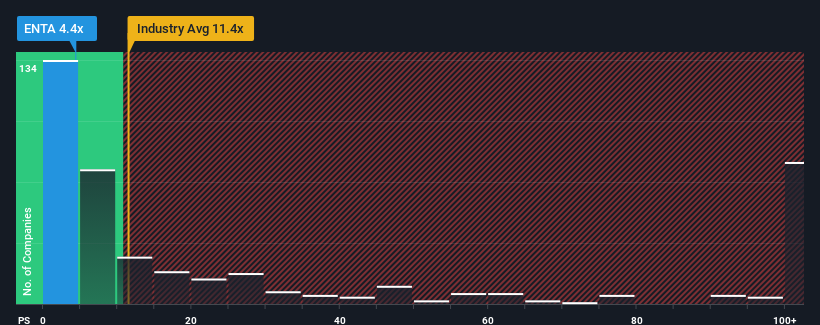- United States
- /
- Biotech
- /
- NasdaqGS:ENTA
Enanta Pharmaceuticals, Inc. (NASDAQ:ENTA) Held Back By Insufficient Growth Even After Shares Climb 26%

Enanta Pharmaceuticals, Inc. (NASDAQ:ENTA) shares have had a really impressive month, gaining 26% after a shaky period beforehand. Not all shareholders will be feeling jubilant, since the share price is still down a very disappointing 19% in the last twelve months.
In spite of the firm bounce in price, Enanta Pharmaceuticals' price-to-sales (or "P/S") ratio of 4.4x might still make it look like a strong buy right now compared to the wider Biotechs industry in the United States, where around half of the companies have P/S ratios above 11.4x and even P/S above 64x are quite common. Nonetheless, we'd need to dig a little deeper to determine if there is a rational basis for the highly reduced P/S.
See our latest analysis for Enanta Pharmaceuticals

What Does Enanta Pharmaceuticals' P/S Mean For Shareholders?
While the industry has experienced revenue growth lately, Enanta Pharmaceuticals' revenue has gone into reverse gear, which is not great. It seems that many are expecting the poor revenue performance to persist, which has repressed the P/S ratio. So while you could say the stock is cheap, investors will be looking for improvement before they see it as good value.
If you'd like to see what analysts are forecasting going forward, you should check out our free report on Enanta Pharmaceuticals.How Is Enanta Pharmaceuticals' Revenue Growth Trending?
The only time you'd be truly comfortable seeing a P/S as depressed as Enanta Pharmaceuticals' is when the company's growth is on track to lag the industry decidedly.
Taking a look back first, the company's revenue growth last year wasn't something to get excited about as it posted a disappointing decline of 10%. This means it has also seen a slide in revenue over the longer-term as revenue is down 23% in total over the last three years. Therefore, it's fair to say the revenue growth recently has been undesirable for the company.
Turning to the outlook, the next three years should generate growth of 6.6% each year as estimated by the eight analysts watching the company. Meanwhile, the rest of the industry is forecast to expand by 204% each year, which is noticeably more attractive.
With this information, we can see why Enanta Pharmaceuticals is trading at a P/S lower than the industry. It seems most investors are expecting to see limited future growth and are only willing to pay a reduced amount for the stock.
What Does Enanta Pharmaceuticals' P/S Mean For Investors?
Enanta Pharmaceuticals' recent share price jump still sees fails to bring its P/S alongside the industry median. We'd say the price-to-sales ratio's power isn't primarily as a valuation instrument but rather to gauge current investor sentiment and future expectations.
We've established that Enanta Pharmaceuticals maintains its low P/S on the weakness of its forecast growth being lower than the wider industry, as expected. At this stage investors feel the potential for an improvement in revenue isn't great enough to justify a higher P/S ratio. It's hard to see the share price rising strongly in the near future under these circumstances.
It is also worth noting that we have found 1 warning sign for Enanta Pharmaceuticals that you need to take into consideration.
If strong companies turning a profit tickle your fancy, then you'll want to check out this free list of interesting companies that trade on a low P/E (but have proven they can grow earnings).
Valuation is complex, but we're here to simplify it.
Discover if Enanta Pharmaceuticals might be undervalued or overvalued with our detailed analysis, featuring fair value estimates, potential risks, dividends, insider trades, and its financial condition.
Access Free AnalysisHave feedback on this article? Concerned about the content? Get in touch with us directly. Alternatively, email editorial-team (at) simplywallst.com.
This article by Simply Wall St is general in nature. We provide commentary based on historical data and analyst forecasts only using an unbiased methodology and our articles are not intended to be financial advice. It does not constitute a recommendation to buy or sell any stock, and does not take account of your objectives, or your financial situation. We aim to bring you long-term focused analysis driven by fundamental data. Note that our analysis may not factor in the latest price-sensitive company announcements or qualitative material. Simply Wall St has no position in any stocks mentioned.
Have feedback on this article? Concerned about the content? Get in touch with us directly. Alternatively, email editorial-team@simplywallst.com
About NasdaqGS:ENTA
Enanta Pharmaceuticals
A biotechnology company, discovers and develops small molecule drugs for the treatment of viral infections and liver diseases.
Undervalued with excellent balance sheet.
Market Insights
Community Narratives




